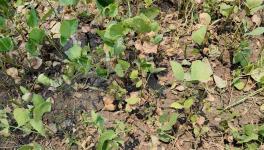UP: Mentha not Minting Money Anymore, Farmers Allege Govt Neglect
Budaun/Barabanki/Jalaun (UP): The aroma of mentha is fast losing its pleasant fragrance thanks to government’s apathy. High input costs and lack of support price have drastically brought down the return of farmers who have already been struggling to increase their incomes.
They are faced with other constraints as well such as electricity supply problem, poor quality of distillation units, inefficient processing technology, climate change, inadequate market information and lack of awareness about export market.
“Gone are the days when mentha cultivation used to give farmers a higher return. With skyrocketing prices of diesel and fertilisers, and almost static purchase price, the input cost has gone too high — resulting into a huge slump in the profit,” said Ashfaq Ali, a farmer from Ikram Nagar in Budaun.
Explaining the economy of the crop, the farmer who had 8.33 acres of mentha field, said, “An acre cultivation of the herb needs an investment between Rs 15,000-20,000. The crop, post distillation, produces mentha oil measuring somewhere around 40 litres. It is sold to traders for Rs 38,000 (Rs 950 per litre). Earlier, when the input cost lower (Rs 10,000-Rs 15,000 per acre), the return was somewhere between Rs 55,000-60,000 per acre.”
Heavy rains in the pre-monsoon season this year came like a disaster as well. The unseasonal heavy rainfall in May this year destroyed the ready to be harvested mentha crop. The month, as per the India Meteorological Department (IMD), was the second wettest May in the past 121 years.
Among those who faced a major blow of the nature’s is Anil Verma from Tandi village in Barabanki district’s Suratganj block. “I had sown mentha on four acres of land. But the incessant rain waterlogged the field, resulting in crop rotting. Three acres of my crop was spoiled. The harvest is not enough to even recover the cost incurred in raising the crop, leave alone the profit,” he told NewsClick.
In Sheikhupur near Badaun, Amir Reyaz too lost his crop and came to bear a loss of around Rs 2,500. He had cultivated mentha on one acre of land by spending Rs 9,500. The unfavourable weather destroyed the crop and reduced the production to 10.5 litres against the estimated volume of over 30 litres.
“I sold it at the rate of Rs 680 per litre. The total return was Rs 7,140 — a loss of Rs 2,360,” he added.
The yield was very good, said Ashish Yadav of village Bengi in Rae Bareli district, but the reasons arising out of the weather played a spoiler; he too could not recover the costs.
Mentha is cultivated during the intermediate period between rabi and kharif seasons. It is normally sown around March-April and harvested in June-July. The farmland is vacant during the time mentha is cultivated. So, it lets farmers do triple harvesting.
Mentha oil is used as industrial input in the manufacture of toothpaste, mouth freshener, medicine, drink, mouthwash, chewing gum, desserts, confectionery and several cosmetic items. Mint leaves are used in beverages, jellies besides pan masala and gutkha-making industries.
Its price keeps fluctuating because it is registered with the Multi Commodity Exchange (MCX), said Khalid Reyaz, who runs a lab in Budaun for testing of the purity of its oil. While mentha oil costs Rs 950 per litre, its variety — essential oil — is sold at Rs 2,500-3,000 per litre.
“It’s very easy to adulterate it by mixing paraffin or turpentine oils. Traders buy it only after a registered lab issues a purity certificate of the sample provided to it by traders,” he added.
With 300,000 hectares of land under its cultivation, India produces 30,000 metric tonnes of mentha every year. The country is the largest producer and exporter in the global market. It exports to around 73 countries across the world, including Europe and China.
Uttar Pradesh shares around 90% of the total mentha production in India. Rising demand in the export market and remunerative prices have boosted mentha farming in the state.
Mint cultivation, according to the state’s Department of Horticulture and Food Processing, is spread across 88,000 hectares of land. While Budaun alone contributes to around 30% of the total production, Barabanki’s share stands between 25-33%.
The department notes, “India has attained position of primary and dominant source of mint oil and menthol in the world market, replacing China to a great extent due to (lower) price structure and comparable quality.”
Around 5 lakh farmers from Budaun grow mentha as their major source of earning. Interestingly, the crop is not damaged by stray animals.
The cash crop is cultivated in districts such as Moradabad, Rampur, Bareilly, Pilibhit, Lakhipur Kheri, Budaun, Sitapur, Barabanki, Shahjahanpur, Bahraich, Ambedkar Nagar, Chandauli and Varanasi.
NO SUPPORT FROM GOVERNMENT
Prateesh Gupta, CEO of Budaun-based Prakash Chemicals, said the industry was self-sustaining and did not get any help from the government. “The government wants to generate maximum revenue from this industry. Farmers have to pay the government 12% GST. Now the government has brought in RCM (Reverse Charge Mechanism). Under GST, tax is imposed on sales, while RCM levies tax on purchase. We have to take tax liability while purchasing the mint from farmers. As a result, we have dual tax liability,” he explained.
He further said the government follows dual policy for mentha -- it is considered as an industrial product under the GST, while it becomes an agricultural produce when it comes to the Mandi Tax.
Mandi Tax is technically not a tax but a fee on the purchase and sale of agriculture produce. It is known as Mandi Tax because states and union territories invoke their powers under the constitution to levy it. Mandi Fee or Mandi Tax is levied to get back the expense of running an agricultural wholesale market, APMC, where farmers get good prices from the buyers.
“The question is if it is an agricultural produce, then why GST is levied on it? And if it is an industrial product, then why is there a Mandi Tax on it?” he asked, alleging that despite mentha being a 100% export-oriented product, the government did not give any incentive to boost its production, processing and export.
“Additionally, there is no green channel for its export,” he said.
Asked about government subsidy of 25% on the total investment, he said it was just a lip service and that too for farmers who never got any such financial assistance.
“The Reserve Bank of India does agriculture financing at lowest rate of interest. Since mentha oil is also considered as an industrial product because it has to be processed and extracted through a mechanical process, we get a loan at the rate of 1.5% on repo rate,” he explained.
The government provides credit linked back ended subsidy of 25% of the total investment or Rs 1.25 lakh and Rs 5 lakh to small and big mentha units respectively, whichever is lower.
As claimed, the subsidy has a central and state component of 85 and 15% respectively. Another scheme gives a subsidy of Rs 11,250 per hectare to mentha farmers for cultivation, subject to a maximum of four hectares.
Meanwhile, the state government has joined hands with the Lucknow-based Central Institute of Medicinal and Aromatic Plants (CIMAP) to impart training to mentha farmers and entrepreneurs. CIMAP is accredited with developing four improved varieties of mentha used in the country, namely Saksham Himalaya, Kushal and Kosi.
“We provide end-to-end training in mentha farming and production of mentha oil. Besides, we also facilitate the marketing of mentha oil,” claimed an official associated with the CIMAP.
The horticulture department also claims that it imparts training to farmers to extract mentha oil from the plant by installing small distillation processing units. But the ground reality is far from the claims. Not even a single farmer told NewsClick that they have ever taken any such training.
He cautioned the government on alleged dumping of artificial menthol in the Indian market by Chinese and German companies. “The government has turned a blind eye. If it is not checked, the industry will soon breathe its last,” he foresaw.
He said the crop has begun losing its sheen because of lack of modern irrigation system, updated technology and research and development.
A downside to the crop is that it requires more water than most agricultural crops. In absence of alternative source of irrigation such as canal and ponds in the drought-prone Bundelkhand region, the crop is rapidly causing depletion of groundwater.
The roots of mentha plants do not penetrate deep into the soil; therefore, it requires 18 to 22 rounds of irrigation in the three months. It requires, as per a study by Gorakhpur Environmental Action Group, about 1,75,000 litres of water to produce one kilogram of menthol.
Get the latest reports & analysis with people's perspective on Protests, movements & deep analytical videos, discussions of the current affairs in your Telegram app. Subscribe to NewsClick's Telegram channel & get Real-Time updates on stories, as they get published on our website.
























